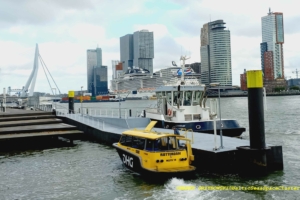Digital twins on ship and in port. Maritime logistics under the supervision of Big Brother

 By Marek Grzybowski
By Marek Grzybowski
“Digital twins” and virtual logistics communities can help cope with supply chain disruptions. Digital twins have already entered the wide waters and are taking over seaports. Attacked by the Covid-19 pandemic, maritime logistics began to introduce IT tools on a large scale to handle connections between continents.
The war in Ukraine and the circumvention of sanctions have incorporated satellite and AI systems into the port and ship surveillance system on an unprecedented scale. Tracking “shadow” ships and STS operations in seaports and anchorages has become common. Thanks to this, we know that not only Russian ports and ships but also ports and operators from countries that have introduced these sanctions are involved in bypassing sanctions and bans.
Missile attacks in the Red Sea region caused global general cargo and bulk cargo routes to have to be adjusted again. Ships returned to the connection from the times of the great discoveries to the routes followed by Cook, Magellan and traders of tea and other goods from India and the Far East.
Disruptions caused by the war in Ukraine and terrorist attacks (also in the West African region) generate further problems. They are related to changes in the logistics of bunkering and crew exchange, as well as the management of operational processes. First of all, they cause disruptions in meeting cruise schedule deadlines. This in turn disrupts the logistics of maritime hub ports based on harmonized connections at sea and on land.
Experts working within the World Economic Forum draw attention to this: Mikael Lind, Senior Research Adviser, Research Institutes of Sweden; Wolfgang Lehmacher, Operating Partner, Industrial Innovation Partners, Anchor Group; Richard T. Watson, Research Director, Digital Frontier Partners; Margi Van Gogh, Head, Supply Chain and Transportation Industry, World Economic Forum.
Digital twin for bottlenecks
Their task today is that global trade suffers from congestion in sea ports and bottlenecks inland at the connections of ports with consumers in industrial and logistics centers. They state the well-known fact that “The Strait of Bab-el-Mandeb between Yemen, Djibouti and Eritrea is a high-risk zone and the Panama Canal has limited capacity.”
In this situation, it is obvious that choosing the optimal route is crucial and requires data insight and analysis. In their opinion, the use of digital twin technology may help in this action. “Digital twins are needed to navigate and inform a variety of possible logistics decisions in interconnected, complex and dynamic trade environments,” say World Economic Forum experts.
It has been known for years that finding the best route for goods from the manufacturer to the customer is a challenge for every logistics operator. Moreover, the issue of delivery optimization has been well known for years as the traveling salesman problem (TSP). Moreover, we have a method to solve this problem in the form of the Hamilton cycle. Moreover, in global logistics we are faced with an asymmetric traveling salesman problem. Even intermediate logistics students can cope with this when solving transport tasks. The use of scheduling may also be useful in solving the traveling salesman problem, even on a global scale. This is a method developed almost 150 years ago by Karol Adamiecki, the Polish creator of management sciences.
Well-known solutions are now supported by information collected from satellites and data clouds, processed into algorithms and “spit out” in the form of proposals for optimal decisions on routes, speeds and destinations to which the ship with the goods should reach.
Digital twins have now been incorporated into this process. Therefore, it should be expected that if a global operator has no business concerns about the cruise, it will leave the cargo in a port convenient for it, and not the customer or the cargo waiting for the cargo. It should be noted that global ship operators are often also global freight forwarders and global terminal and even port managers.
Storms in maritime logistics
Only briefly did line and container terminal operators manage to find the balance that was lost after the chaos caused by Covid. Just when it seemed that the time had come to reap the harvest with a surge in freight, a wave of crisis hit the container market. The PRC, with its policy of drastic combat against subsequent waves of Covid, has created a loop of its own, creating Gordian knots in ports.
After several months of apparent stabilization, we again observed congestion in container terminals, shortages of empty containers, and congestion in intermodal transport caused by sanctions introduced by developed countries after Russia’s attack on Ukraine.
According to World Economic Forum experts, “The global supply system is a maze, and without a comprehensive, system-wide view, individual interventions may have unforeseen and undesirable consequences.”
– The industry’s ability to act coherently and the likelihood of positive results can be increased by a digital model of the shipping industry – postulate Lind, Lehmacher, Watson and Van Gogh.
It should be part of the global supply system. It must be constantly calibrated using dynamic data flows obtained from the automatic identification system with information received in real time from points in the logistics network.
A digital twin, i.e. a virtual (IT) copy of a real technical element, process or system, e.g. transport or sea port, is intended to help control global logistics networks. This technology allows you to design and practice operating scenarios of technical facilities and transport systems on a computer. A well-built program allows you to design possible disruptions in processes and operating systems and optimize, for example, transport processes.
Logistics under the supervision of satellite and AI
However, what the World Economic Forum experts postulate is already happening and is working more and more efficiently. Global logistics uses increasingly better IoT tools. Satellite systems and computer operating systems are widely used in the management of fleets, terminals and ports, and supply chains to hubs and logistics centers.
– Maritime logistics, the complex dance of ships, ports and cargo, is undergoing a profound transformation. Industry 4.0 technologies weave a digital thread into the heart of this sector, introducing unprecedented efficiency and resilience. The maritime industry is playing a leading role in responding to the challenges of slow-balization as geopolitical changes and global events require a reassessment of supply chain strategies, write poetically Vinay Nyamati, Managing Director, V & V Comptech Systems (V&VCS) and Gnanesh Asagodu, Director-Engineering V&VCS.
Maritime and land space is a network that carries terabytes of information about goods and containers, ships and operators. Thanks to artificial intelligence, IoT and digital twins, not only ship traffic, but also container and general cargo traffic are optimized. Coal, oil and gas are transported under the watchful eye of the satellite.
– Forecasting, inventory optimization and preventing production errors are paramount. It is predicted that specialized AI chips integrated with the supply chain will generate revenues of approximately USD 130 billion annually in 2030, which imposes the need for effective forecasting and inventory management, Nyamati and Asagodu believe.
Ships, ports and goods in the virtual network
The Virtual Watchtower (VWT) initiative is an example of using human-machine (or rather human-computer) interaction to eliminate disruptions in global logistics networks. This is an extremely innovative way of managing connections between entities operating in maritime transport, and actually the entire global logistics network.
VWT is based on building a global community and integrating it with the world of IT solutions. Working together, participants of the logistics network from different sides jointly develop a digital solution. This makes it possible to deal with crises and challenges caused by surprising situations better, faster and more efficiently.
As a community grows, so do the benefits for each party and the community as a whole. Continuous co-creation ensures that the solution is much more likely to be useful. VWT complements existing visibility solutions with more accurate data. For this purpose, the MetroMap tool is implemented.
This is dictated by the logic of data sharing in multi-organizational environments. As in all solutions for collaborative decision-making (CDM), visualization in the MetroMap formula is necessary – explain the initiators of VWT. This form not only provides visualization but also determines the roles of participants in the global logistics harmonization process.
At the same time, it visualizes the key points of coordination of operations in which the participants of the logistics process operate. You can see the interdependence of data and decisions in real time. You can monitor the implementation of plans on an ongoing basis. The routes of means of transport, containers and loads are visible between the points in the schedule.
The digital twin of the logistics process in maritime transport provides a full representation of the ship’s cargo space with cargo, its route and operating conditions during sea passage and in the terminal. This became possible thanks to satellite observation and AI controlling the movement of units even after turning off the identification systems. Maritime logistics operates under the supervision of Big Brother.
